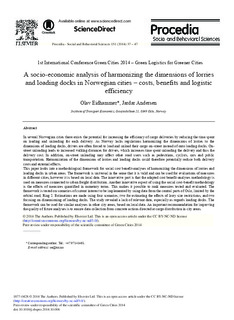| dc.contributor.author | Eidhammer, Olav | |
| dc.contributor.author | Andersen, Jardar | |
| dc.coverage.spatial | Norway | nb_NO |
| dc.date.accessioned | 2019-06-26T14:14:45Z | |
| dc.date.available | 2019-06-26T14:14:45Z | |
| dc.date.created | 2015-02-09T14:05:28Z | |
| dc.date.issued | 2014-12-03 | |
| dc.identifier.citation | Procedia - Social and Behavioral Sciences. 2014, 151, 37-47. | nb_NO |
| dc.identifier.issn | 1877-0428 | |
| dc.identifier.uri | http://hdl.handle.net/11250/2602407 | |
| dc.description.abstract | In several Norwegian cities there exists the potential for increasing the efficiency of cargo deliveries by reducing the time spent on loading and unloading for each delivery. As Norway lacks regulations harmonizing the dimensions of lorries to the dimensions of loading docks, drivers are often forced to load and unload their cargo on-street instead of onto loading docks. On-street unloading leads to increased walking distances for drivers, which increases time spent unloading the delivery and thus the delivery cost. In addition, on-street unloading may affect other road users such as pedestrians, cyclists, cars and public transportation. Harmonization of the dimensions of lorries and loading docks could therefore potentially reduce both delivery costs and external effects. This paper looks into a methodological framework for social cost benefit-analyses of harmonizing the dimensions of lorries and loading docks in urban areas. The framework is universal in the sense that it is valid and can be used for evaluations of measures in different cities, however it is based on local data. The innovative part is that the adapted cost benefit-analyses methodology is used on measures connected to urban freight distribution. Another innovative aspect of using the social cost-benefit methodology is the effects of measures quantified in monetary terms. This makes it possible to rank measures tested and evaluated. The framework is tested on scenarios of current interest to be implemented by using data from the central parts of Oslo, limited by the orbital road, Ring 2. Estimations are made using four scenarios; two for estimating the effects of lorry size restrictions, and two focusing on dimensioning of loading docks. The study revealed a lack of relevant data, especially as regards loading docks. The framework can be used for similar analyses in other city areas, based on local data. An important recommendation for improving the quality of future analyses is to ensure data collection from concrete actions directed at cargo distribution in city areas. | nb_NO |
| dc.language.iso | eng | nb_NO |
| dc.publisher | Elsevier | nb_NO |
| dc.rights | Attribution-NonCommercial-NoDerivatives 4.0 Internasjonal | * |
| dc.rights.uri | http://creativecommons.org/licenses/by-nc-nd/4.0/deed.no | * |
| dc.title | A Socio-economic Analysis of Harmonizing the Dimensions of Lorries and Loading Docks in Norwegian Cities – Costs, BenefIts and Logistic Efficiency | nb_NO |
| dc.title.alternative | A Socio-economic Analysis of Harmonizing the Dimensions of Lorries and Loading Docks in Norwegian Cities – Costs, BenefIts and Logistic Efficiency | nb_NO |
| dc.title.alternative | A Socio-economic Analysis of Harmonizing the Dimensions of Lorries and Loading Docks in Norwegian Cities – Costs, Benefits and Logistic Efficiency | nb_NO |
| dc.type | Journal article | nb_NO |
| dc.type | Peer reviewed | nb_NO |
| dc.rights.holder | © 2014 The Authors. Published by Elsevier Ltd. | nb_NO |
| dc.description.version | publishedVersion | nb_NO |
| cristin.unitcode | 7482,0,0,0 | |
| cristin.unitname | Transportøkonomisk institutt | |
| cristin.ispublished | true | |
| cristin.fulltext | original | |
| cristin.qualitycode | 1 | |
| dc.identifier.doi | 10.1016/j.sbspro.2014.10.006 | |
| dc.identifier.cristin | 1219119 | |
| dc.source.journal | Procedia - Social and Behavioral Sciences | nb_NO |
| dc.source.volume | 151 | nb_NO |
| dc.source.pagenumber | 37-47 | nb_NO |

